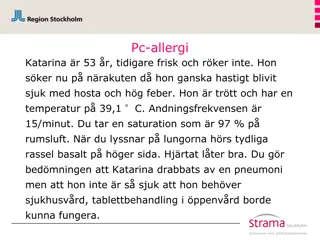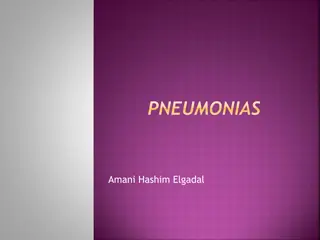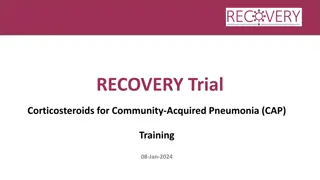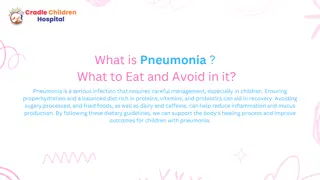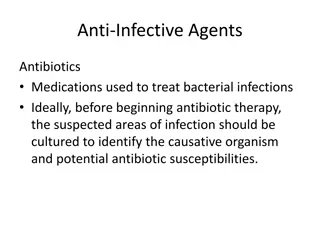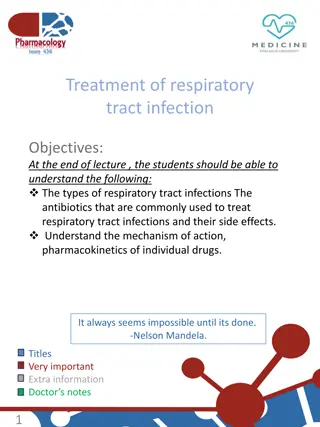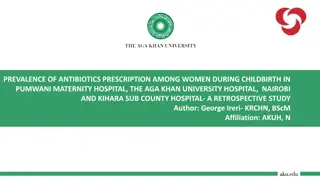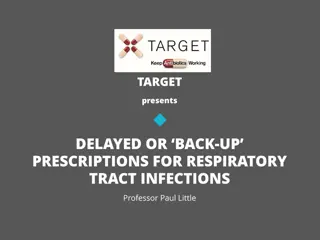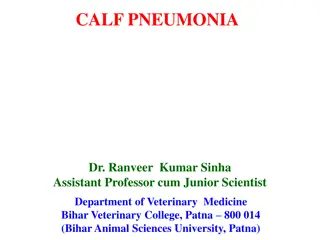Antibiotics in Action: Pneumonia Management with Ceftriaxone
Dr. Alyssa Castillo presents strategic antibiotic selection tools for common infections like pneumonia, UTI, and cellulitis, focusing on frequently utilized antibiotics like ceftriaxone. The case study explores treating a 55-year-old pneumonia patient with IV ceftriaxone and discusses additional antibiotic options. No financial disclosures related to ceftriaxone manufacturers are reported.
Download Presentation

Please find below an Image/Link to download the presentation.
The content on the website is provided AS IS for your information and personal use only. It may not be sold, licensed, or shared on other websites without obtaining consent from the author.If you encounter any issues during the download, it is possible that the publisher has removed the file from their server.
You are allowed to download the files provided on this website for personal or commercial use, subject to the condition that they are used lawfully. All files are the property of their respective owners.
The content on the website is provided AS IS for your information and personal use only. It may not be sold, licensed, or shared on other websites without obtaining consent from the author.
E N D
Presentation Transcript
Antibiotics in Action Antibiotics in Action (Hint: the answer is almost always ceftriaxone ) Alyssa Castillo, MD Division of Infectious Diseases University of Washington
Disclosures No financial disclosures Specifically: No financial relationship with the manufacturers of ceftriaxone!
Learning Objectives To give you tools to strategically select antibiotics for the BIG 3 infections: pneumonia, UTI, and cellulitis To flip the narrative and focus on the most frequently utilized antibiotics and their spectrum (rather than review them all) Today we will NOT discuss: Antibiotic mechanism of action Drug dosing Duration of therapy
Ceftriaxone Slide credit: Drs David Spach and Paul Pottinger
Case 1: Pneumonia A 55-year-old patient presents to the ED with fevers, chills, cough, and purulent sputum. A chest XR shows a lobar consolidation.
Case 1: Pneumonia Audience Response Question A 55-year-old patient presents to the ED with fevers, chills, cough, and purulent sputum. You start IV ceftriaxone + which additional antibiotic? A chest XR shows a lobar consolidation. Vancomycin Azithromycin Trimethoprim-sulfamethoxazole (Bactrim) They are diagnosed with community-acquired pneumonia, and admission is planned.
Case 1: Pneumonia Audience Response Question A 55-year-old patient presents to the ED with fevers, chills, cough, and purulent sputum. You start IV ceftriaxone + which additional antibiotic? A chest XR shows a lobar consolidation. Vancomycin Azithromycin Trimethoprim-sulfamethoxazole (Bactrim) They are diagnosed with community-acquired pneumonia, and admission is planned.
Covers relevant GNRs: -H influenzae -M catarrhalis Good strep ! Ceftriaxone Slide credit: Drs David Spach and Paul Pottinger
Azithromycin In pneumonia: Cornerstone of therapy for atypical organisms Mycoplasma pneumoniae Legionella pneumophila Chlamydophila pneumoniae Active against someStrep pneumoniae Active against many Gram(+) and Gram(-) organisms HOWEVER, use is limited because resistance is on the rise
Case 1: Pneumonia 1. For Community-Acquired Pneumonia (CAP), use ceftriaxone + azithromycin.
Case 1b: Pneumonia Audience Response Question A 55-year-old patient with COPD presents to their primary care physician with fevers, chills, cough, and purulent sputum. What antibiotic would you recommend? Azithromycin Amoxicillin-clavulanate (Augmentin) + azithromycin Trimethoprim-sulfamethoxazole (Bactrim) Cephalexin A chest XR shows a lobar consolidation. They are diagnosed with community-acquired pneumonia. Outpatient treatment is planned.
Case 1b: Pneumonia Audience Response Question A 55-year-old patient with COPD presents to their primary care physician with fevers, chills, cough, and purulent sputum. What antibiotic would you recommend? Azithromycin Amoxicillin-clavulanate (Augmentin) + azithromycin Trimethoprim-sulfamethoxazole (Bactrim) Cephalexin A chest XR shows a lobar consolidation. They are diagnosed with community-acquired pneumonia. Outpatient treatment is planned.
Good strep ! Covers relevant GNRs: -H influenzae -M catarrhalis Also covers anaerobes a good choice if high suspicion for aspiration Amoxicillin-clavulanate (i.e. Augmentin) Slide credit: Drs David Spach and Paul Pottinger
Case 1: Pneumonia 1. For inpatient Community-Acquired Pneumonia (CAP), use ceftriaxone + azithromycin. 2. For outpatient Community-Acquired Pneumonia (CAP) in pts with comorbidities, use amoxicillin-clavulanate + azithro. Alternate: respiratory fluoroquinolone (levofloxacin or moxifloxacin)
Case 1c: Pneumonia Audience Response Question A 55-year-old patient is hospitalized for chest pain due to an NSTEMI. 7d after admission, they develop fevers, chills, cough, and purulent sputum. A chest XR shows a lobar consolidation. What antibiotic(s) would you start? Ceftriaxone Cefepime Vancomycin Ceftriaxone + Vancomycin Cefepime + Vancomycin They are diagnosed with hospital- acquired pneumonia.
Case 1c: Pneumonia Audience Response Question A 55-year-old patient is hospitalized for chest pain due to an NSTEMI. 7d after admission, they develop fevers, chills, cough, and purulent sputum. A chest XR shows a lobar consolidation. What antibiotic(s) would you start? Ceftriaxone Cefepime Vancomycin Ceftriaxone + Vancomycin Cefepime + Vancomycin They are diagnosed with hospital- acquired pneumonia.
What pneumonia pathogens does ceftriaxone miss? Pseudomonas aeruginosa Resistant GNRs MRSA Ceftriaxone Slide credit: Drs David Spach and Paul Pottinger
Improved Gram- negative coverage (including Pseudomonas!) Cefepime Slide credit: Drs David Spach and Paul Pottinger
MRSA coverage! Vancomycin Slide credit: Drs David Spach and Paul Pottinger
Case 1: Pneumonia 1. For inpatient Community-Acquired Pneumonia (CAP), use ceftriaxone + azithromycin. 2. For outpatient Community-Acquired Pneumonia (CAP) in pts with comorbidities, use amoxicillin-clavulanate + azithro. Alternate: respiratory fluoroquinolone (levofloxacin or moxifloxacin) 3. For Hospital-Acquired Pneumonia (HAP), use cefepime + vancomycin. Goal: To additionally cover MRSA, Pseudomonas, more GNRs
Case 2: Urinary Tract Infection (UTI)
Case 2a: UTI Audience Response Question A 35-year-old cisgender woman with no PMH presents to the ED with fevers, chills, flank pain, and dysuria. A urinalysis is positive, and a urine culture is pending. What antibiotic would you start? Ceftriaxone Cefepime Vancomycin Levofloxacin She is diagnosed with pyelonephritis, and admission is planned.
Case 2a: UTI Audience Response Question A 35-year-old cisgender woman with no PMH presents to the ED with fevers, chills, flank pain, and dysuria. A urinalysis is positive, and a urine culture is pending. What antibiotic would you start? Ceftriaxone Cefepime Vancomycin Levofloxacin She is diagnosed with pyelonephritis, and admission is planned.
What UTI pathogens does ceftriaxone cover? Uropathogenic E coli (~75%!) Klebsiella (6%) Proteus (6%) Staph saprophyticus (6%) Group B strep (3%) Ceftriaxone Slide credit: Drs David Spach and Paul Pottinger
Case 2: Urinary Tract Infection (UTI) 1. For inpatient UTI in a patient without risk factors for resistance*, use ceftriaxone. *Risk factors: recent urologic procedure, history of MDRO, etc.
Case 2b: UTI Audience Response Question A 35-year-old cisgender woman presents to her primary care physician (PCP) with fevers, chills, flank pain, and dysuria. A urinalysis is positive, and a urine culture is pending. What antibiotic would you send to her pharmacy? Ceftriaxone Ciprofloxacin Amoxicillin She is diagnosed with pyelonephritis, and of course you give a dose of ceftriaxone in the office. Discharge to home is planned.
Case 2b: UTI Audience Response Question A 35-year-old cisgender woman presents to her primary care physician (PCP) with fevers, chills, flank pain, and dysuria. A urinalysis is positive, and a urine culture is pending. What antibiotic would you send to her pharmacy? Ceftriaxone Ciprofloxacin Amoxicillin She is diagnosed with pyelonephritis, and of course you give a dose of ceftriaxone in the office. Discharge to home is planned.
Additional benefits of FQ: High bioavailability Excellent renal penetration Can be safely used in bacteremia (PO)
Case 2: Urinary Tract Infection (UTI) 1. For inpatient pyelonephritis in a patient without risk factors for resistance*, use ceftriaxone. *Risk factors: recent urologic procedure, history of MDRO, etc. 2. For outpatient pyelonephritis, use ciprofloxacin or levofloxacin. Excellent bioavailability and kidney penetration
Case 2c: UTI Audience Response Question A 35-year-old cisgender woman presents to her primary care physician (PCP) with urinary frequency, urgency, dysuria, and suprapubic pain. A urinalysis is positive, and a urine culture is pending. What antibiotic would you start? Ceftriaxone Levofloxacin Doxycycline Nitrofurantoin She is diagnosed with cystitis.
Case 2c: UTI Audience Response Question A 35-year-old cisgender woman presents to her primary care physician (PCP) with urinary frequency, urgency, dysuria, and suprapubic pain. A urinalysis is positive, and a urine culture is pending. What antibiotic would you start? Ceftriaxone Levofloxacin Doxycycline Nitrofurantoin She is diagnosed with cystitis.
Empiric Cystitis Treatment: 3 Options Empiric Cystitis Treatment: 3 Options Nitrofurantoin Caution with use in elderly or GFR < 30 CAUTION IN UPPER TRACT DISEASE Does not penetrate kidneys Fosfomycin Expensive! Typically not used for upper tract disease (though data here is evolving!) TMP/SMX
Keep in mind the common UTI pathogens: Uropathogenic E coli (~75%!) Klebsiella (6%) Proteus (6%) Staph saprophyticus (6%) Group B strep (3%) Trimethoprim-Sulfamethoxazole (i.e. Bactrim or TMP-SMX ) Slide credit: Drs David Spach and Paul Pottinger
Empiric Cystitis Treatment: 3 Options Empiric Cystitis Treatment: 3 Options Nitrofurantoin Caution in the elderly or GFR < 30 CAUTION IN UPPER TRACT DISEASE Does not penetrate kidneys Fosfomycin Expensive! Typically not used for upper tract disease (though data here is evolving!) TMP/SMX CAUTION with resistance >20%
Empiric Cystitis Treatment: 3 Options Empiric Cystitis Treatment: 3 Options Nitrofurantoin Caution in elderly or GFR < 30 CAUTION IN UPPER TRACT DISEASE Does not penetrate kidneys Fosfomycin Expensive! Typically not used for upper tract disease (though data here is evolving!) TMP/SMX CAUTION with resistance >20% Audience Response Question Cipro isn t on the list! Why do you think that is? Too much resistance Too expensive Too many side effects
Empiric Cystitis Treatment: 3 Options Empiric Cystitis Treatment: 3 Options Nitrofurantoin Caution in elderly or GFR < 30 CAUTION IN UPPER TRACT DISEASE Does not penetrate kidneys Fosfomycin Expensive! Typically not used for upper tract disease (though data here is evolving!) TMP/SMX CAUTION with resistance >20% Audience Response Question Cipro isn t on the list! Why do you think that is? Too much resistance Too expensive Too many side effects
Case 2: Urinary Tract Infection (UTI) 1. For inpatient pyelonephritis in a patient without risk factors for resistance*, use ceftriaxone. *Risk factors: recent urologic procedure, history of MDRO, etc. 2. For outpatient pyelonephritis, use ciprofloxacin or levofloxacin. Excellent bioavailability and kidney penetration 3. For cystitis, use fosfomycin or nitrofurantoin. AVOID fluoroquinolones unless no other options AVOID empiric bactrim if local E coli resistance > 20%
Case 3: Skin and Soft Tissue Infection (SSTI)
Case 3: SSTI Audience Response Question A 75-year-old patient presents to the ED after a fall with abrasion on the right lower extremity, followed by development of pain and swelling. The exam is notable for unilateral erythema, edema, and tenderness to palpation. The ED starts vancomycin + ceftriaxone, and they are admitted. How would you narrow antibiotic therapy? Ceftriaxone Vancomycin Cefazolin They are diagnosed with cellulitis.
Case 3: SSTI Audience Response Question A 75-year-old patient presents to the ED after a fall with abrasion on the right lower extremity, followed by development of pain and swelling. The exam is notable for unilateral erythema, edema, and tenderness to palpation. The ED starts vancomycin + ceftriaxone, and they are admitted. How would you narrow antibiotic therapy? Ceftriaxone Vancomycin Cefazolin They are diagnosed with cellulitis.
Good strep ! An aside: Cefazolin is the gold standard for methicillin-susceptible staph aureus (MSSA). Cefazolin In terms of coverage: IV cefazolin = PO cephalexin Slide credit: Drs David Spach and Paul Pottinger
Case 3: SSTI 1. For non-purulent cellulitis, use: IV: cefazolin PO: cephalexin ( Keflex )
Case 3b: SSTI Audience Response Question A 75-year-old patient presents to the ED after a fall with abrasion on the right lower extremity, followed by development of pain and swelling. The exam is notable for unilateral erythema, edema, tenderness to palpation, and a fluctuant fluid collection. The ED starts vancomycin + ceftriaxone, and they are admitted. What is the next best step? Narrow to vanco alone Narrow to ceftriaxone alone I&D the abscess Narrow to vanco + I&D Narrow to ceftriaxone + I&D They are diagnosed with cellulitis with soft tissue abscess.
Case 3b: SSTI Audience Response Question A 75-year-old patient presents to the ED after a fall with abrasion on the right lower extremity, followed by development of pain and swelling. The exam is notable for unilateral erythema, edema, tenderness to palpation, and a fluctuant fluid collection. The ED starts vancomycin + ceftriaxone, and they are admitted. What is the next best step? Narrow to vanco alone Narrow to ceftriaxone alone I&D the abscess Narrow to vanco + I&D Narrow to ceftriaxone + I&D They are diagnosed with cellulitis with soft tissue abscess.
MRSA coverage! Vancomycin
Case 3c: SSTI Audience Response Question A 75-year-old patient presents to the ED after a fall with abrasion on the right lower extremity, followed by development of pain and swelling. The exam is notable for unilateral erythema, edema, tenderness to palpation, and a fluctuant fluid collection. They are now ready for discharge. What is the best oral antibiotic option? Cephalexin Ciprofloxacin TMP-SMX (Bactrim) They are diagnosed with cellulitis with soft tissue abscess.
Case 3c: SSTI Audience Response Question A 75-year-old patient presents to the ED after a fall with abrasion on the right lower extremity, followed by development of pain and swelling. The exam is notable for unilateral erythema, edema, tenderness to palpation, and a fluctuant fluid collection. They are now ready for discharge. What is the best oral antibiotic option? Cephalexin Ciprofloxacin TMP-SMX (Bactrim) They are diagnosed with cellulitis with soft tissue abscess.


